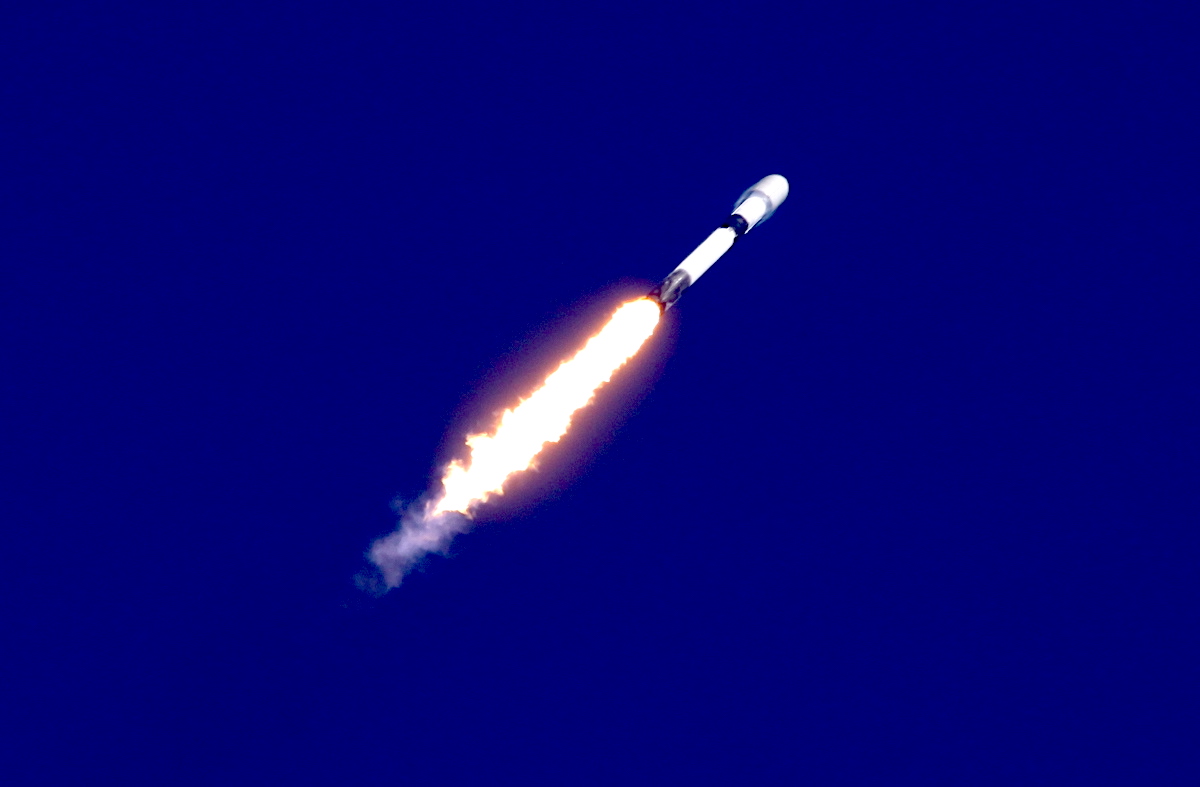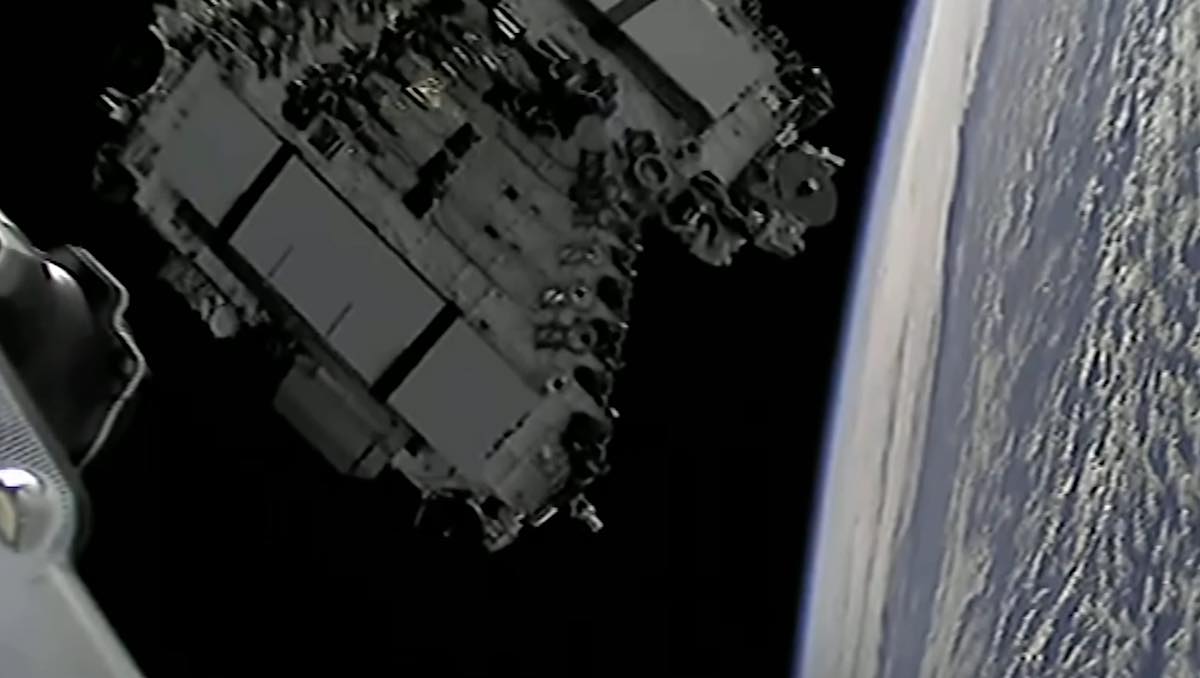
SpaceX says the effects of a solar storm will destroy as many as 40 of 49 new Starlink internet satellites launched from Florida last week.
Some of the satellites have already re-entered the atmosphere, and more are expected to plunge back to Earth in the coming days. The satellites are designed to burn up when they fall to Earth.
A Falcon 9 rocket launched SpaceX’s newest 49 Starlink internet satellites Thursday, Feb. 3, from NASA’s Kennedy Space Center in Florida. The satellites deployed all at once from the rocket’s second stage about 15 minutes after launch. SpaceX said the rocket placed the satellites into an on-target orbit with a perigee, or low point, about 130 miles (210 kilometers) above Earth.
Typically, the satellites deploy their solar panels to start generating electricity, then use ion thrusters to maneuver to their operating altitude of 335 miles (540 kilometers). But SpaceX said the satellites launched last Thursday were “significantly impacted” by a geomagnetic storm triggered by a solar flare.
A space weather forecast issued by NOAA last week — before the Starlink launch — predicted a “moderate” geomagnetic storm caused by a solar flare that occurred Jan. 29. Eruptions from the sun send bursts of radiation into the solar system, and can lead to bursts of charged particles and auroral displays when they interact with Earth’s magnetic field.
Geomagnetic storms can impact radio transmissions and electrical grids. They can also interfere with satellite operations, either from more radiation exposure or increased atmospheric drag.
Energy added to the Earth’s atmosphere from an uptick in solar activity causes the atmosphere to warm and swell outward. Higher density air replaces the rarefied molecules previously present at altitudes a few hundred miles above Earth, where the Starlink satellites and other spacecraft fly.
SpaceX said GPS navigation data from the new batch of Starlink satellites showed an increase in atmospheric drag 50 percent higher than during previous launches. Ground controllers commanded the flat-panel satellites into a safe mode where they would fly edge-on against the atmosphere to minimize drag, according to SpaceX.
“Preliminary analysis show the increased drag at the low altitudes prevented the satellites from leaving safe-mode to begin orbit raising maneuvers, and up to 40 of the satellites will re-enter or already have re-entered the Earth’s atmosphere,” SpaceX said in an update posted on its website.
The increase in atmospheric drag commonly affects satellites in low Earth orbit, but the Starlink satellites launch to a very low altitude, leaving little margin to overcome any additional drag.
SpaceX said it deploys Starlink satellites into low orbits so they can quickly drop out of orbit if they fail. Once SpaceX confirms a satellite is healthy, teams send commands to begin orbit-raising into the operational Starlink network.
“While the low deployment altitude requires more capable satellites at a considerable cost to us, it’s the right thing to do to maintain a sustainable space environment,” SpaceX said.
There’s also another benefit to launching into a low orbit. A Falcon 9 rocket can haul more Starlink spacecraft on a single mission if it targets a lower altitude.
SpaceX said the doomed Starlink spacecraft “pose zero collision risk” with other satellites. The Starlink satellites are designed to burn up entirely when they re-enter the atmosphere, meaning no debris will hit the ground as they fall out of orbit.

The launch last week was the 36th Falcon 9 flight dedicated to deploying satellites for SpaceX’s Starlink broadband network. With the 49 new satellites on that mission, SpaceX has now launched 2,091 Starlink spacecraft since 2018, including prototypes.
The satellites are built by SpaceX in Redmond, Washington, and each weigh more than a quarter-ton.
Nearly 200 of the satellites have fallen out of orbit, and around 300 of the newest spacecraft are currently moving into their assigned orbital slot, according to a tabulation maintained by Jonathan McDowell, an astrophysicist and expert tracker of spaceflight activity.
McDowell’s chart shows 1,516 Starlink satellites are currently operational and providing internet service. SpaceX does not regularly release details about the number of satellites in its active constellation.
SpaceX is in the midst of deploying of around 4,400 Starlink satellites in five orbital “shells” at slightly different altitudes and at different inclinations, or angles to the equator, enough to provide global internet connectivity. The company’s recent launches, including the Feb. 3 mission, have targeted an orbital shell at an inclination of 53.2 degrees and an altitude of 335 miles (540 kilometers).
The company has plans to eventually launch as many as 42,000 Starlink satellites to expand internet coverage, an ambitious goal that could be aided by the start of missions using SpaceX’s next-generation heavy-lift Starship rocket.
OneWeb is also building out a fleet of small satellites that will initially number 648 spacecraft, but could eventually total in the thousands. Amazon plans to launch 3,236 satellites for its own internet service.
Companies in China also plan to launch satellite “megaconstellations” for broadband internet connectivity, and the European Union is developing its own concept for a large fleet of satellites in low Earth orbit.
With the sun’s 11-year solar cycle building to its next maximum in 2025, an increase in atmospheric drag could have more consequences for small satellite operators. Such effects may become less rare as the sun nears solar maximum, McDowell wrote on Twitter.
“Given the increasing likelihood of similar (or worse) space weather as we approach a new solar max, and now knowing the potential consequences, will SpaceX take a different approach to its Starlink launches?” tweeted Hugh Lewis, a professor at the University of Southampton and a specialist in space debris research.
SpaceX did not respond to an inquiry from Spaceflight Now on whether it might adjust plans for future Starlink launches in response to the risks from geomagnetic storms.
Email the author.
Follow Stephen Clark on Twitter: @StephenClark1.
from Spaceflight Now https://ift.tt/5Y9MJCg
via World Space Info







0 comments:
Post a Comment